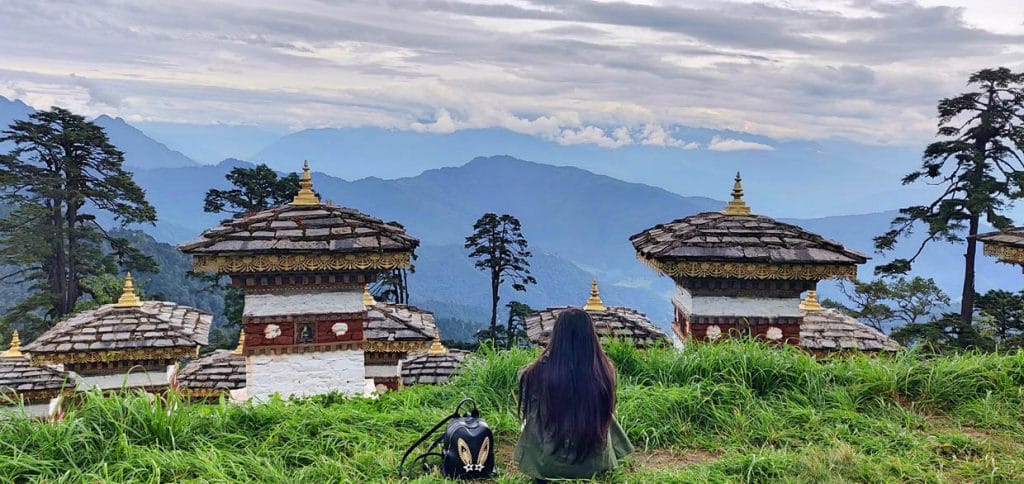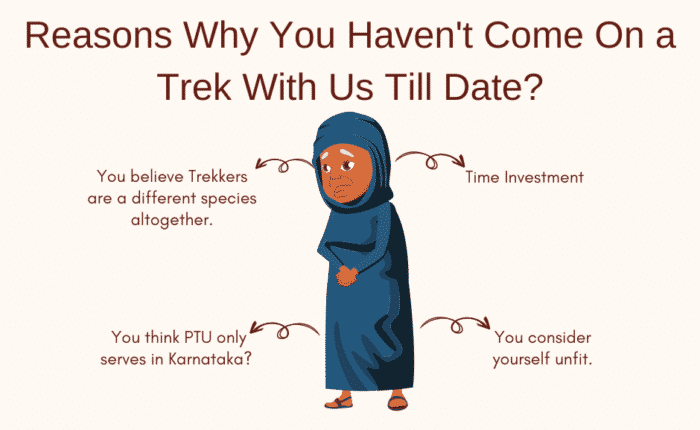Trekking is an appealing activity to know the western side of the Indian peninsula.
The panorama, the hottest biodiversity, undulating terrain, and diverse flora and fauna encourages everyone to see the same in its authentic wellness. Still, trekking as an adventurous sport also requires preparation beforehand, which translates to spending hours in shops or online stores and looking for the best products. Now, some trekkers love preparing, while for others, it is an absolute cause of anxiety. We get all of you!
At Plan the Unplanned, we regularly receive questions about what to carry. Hence, we thought of making a repository of essential items to carry on a western ghats trek. Most treks in Western ghats will range from 2 to 3 days.
All the items listed below are budget-friendly and have been enlisted by keeping in mind the best of reviews, cost and durability of the products:
Table of Contents
Clothes
〉T-Shirts
Carry two synthetic or mix fabric t-shirts, preferably full sleeved to prevent your skin from sun damage.
Although most of us prefer to wear cotton shirts, synthetic shirts would dry the sweat quickly. Plus, if it rains, the synthetic shirt will take much less time to dry than the cotton one.
Take two synthetic and one cotton shirt to wear in your tent for a cosy stay at night.
〉Pants
Here, you can follow the two plus one strategy. Smartness is in carrying two dri-fit pants and one cotton pants. Dri-fit pants are light in weight and dries quickly. Cotton pants will come in handy at night.
〉Undergarments
Take at least three pairs of undergarments. If one pair gets wet, you can change it right away to prevent any kind of infection.
〉Warm Jacket
At an approximate height of 1800 m, the temperature can go down to 5 degrees in winters. In this, carrying a warm layer can save you from the cold while travelling, at your stay or while taking a stroll in the nearby area.
Foot Wear
〉Shoes
Shoes with good grip can be the maker or breaker of your trek – especially during the monsoon. We have seen trekkers struggling with their grip while on the trail. Decent sports shoes with good grip can work, but if you have a choice, go for proper trekking shoes.
Read – How to select the best trekking shoes?
〉Flip Flops
You can wear shoes while on the trek. Flip flops will be convenient for your legs to relax and let them breathe for the rest of the time.
Accessories
〉Sun Cap
The use of a sun cap is underestimated. It can be used to cover your face and neck from sun damage and burn.
At the altitude of the Western Ghats, even dim sunlight contains UVA and UVB radiation which can cause skin damage and, in some severe cases. Sun caps will save you from direct radiation exposure.
〉Socks
Socks keep your feet from rubbing against the lining of shoes and give you an extra cushion for walking. Additionally, they save the shoe from getting wet from the sweat – this helps prevent excess dirt or microbes from accumulating on the shoe and consequently saves it from foul smell.
Plus, during monsoon, socks help in preventing leeches from contacting the skin directly. Also, read how to handle leeches on a monsoon trek?
Medicines
A medicine kit is like health Insurance – not valuable, but a buzz at the time of emergency. Your trek or base will mostly be in the thinly populated region and will have minimal amenities. A medical kit might save you from a lot of hassle.
It must contain Disprin (in case of headache), Electrol (in case of dehydration), sanitiser, band-aid (for minor cuts and injuries), Odomos (for protection against mosquitoes) and cotton.
Electrical Equipment
〉PowerBank
If you are camping, this is a must. A fully charged power bank can give your mobile phone and camera gears sufficient charging for a day.
〉Headlamp/Torch
A headlamp is required for night functions like going to the loo or in general while you are inside the camp. Nowadays, all phones are equipped with a torch, but there is no harm in carrying a headlamp or a torch if you want to save mobile power.
Trekking and Camping Gears
〉Raincoat or Poncho
Raincoat and poncho both are used to protect you against rain. Both have their set of pros and cons.
Raincoats are more useful in the western ghats trek, but they can’t save your backpack from rain.
Poncho is open and with a lot of extra space that can be used to cover up your backpack. They are well-ventilated and can be worn and taken off speedily.
¤ Tip – We recommend you to buy a raincoat over a poncho for a western ghats trek because of the following reasons:
-
- Firstly, at high altitudes, the wind speed can get uncontrollably strong. The same wind will enter through your baggy poncho and will make it very difficult for you to walk.
- Secondly, the backpack you carry on the trail is a smaller one containing basic things like food, water, a dry cloth, etc. A small backpack can be worn over the raincoat, and a rain cover can be used on top of it.
You will leave your stuff at the campsite, go for the trek and come back the same day or the next day.
¤ Tip – Don’t purchase rain pants; instead, get a raincoat and dri-fit pants. The combination will do its job against the rain.
〉Raincover for Backpack
Now that we have emphasised so much on the use of a raincoat on a western ghats trek, you must have understood how indispensable your rain cover is. Raincover should be carried both for a small and big backpack.
〉Camp
If you are planning to stay in a camp instead of a homestay or hotel, we recommend you check the following:
〉Sleeping Bag
The sleeping bag will keep you warm and dry for the night and will also give you a cosy place to sleep.
〉Trekking Pole
A trekking pole is used to transfer your body weight on the poles, move swiftly, traverse along narrow ridgelines, hold your ground on loose sand or wet mud, and remain upright in case of strong wind.
In the end, you will save ounces of energy.
Toiletry
〉Face Wash
A single facewash can be used as a multi-purpose toiletry item: handwash, facewash, body wash, etc.
We are talking about essentials here. Anyways you can carry as much as you want to, but remember that less is more on a trek.
-
- Sunskin cream – Just like suncap, a good sun skin cream will save you from harsh UVA and UVB rays.
- Moisturiser – Once you are done with the trek, use a moisturiser on your face, neck area, skin and leg. It will keep your skin hydrated and will help in regaining its glow.
Backpacks
There are many varieties of bags and rucksacks available in the market. You can purchase a 40-50 L backpack. Follow this ultimate guide to choosing the right backpack.
Cutlery
- Water bottle
- Spoon
- Lunch Box
¤ Tip – Never leave anything on the trail. You must have read/heard about it several times, but we also see people leaving traces of plastic, water bottles, chips and chocolate wrappers. Collect your waste and throw it at the right place.
Also, Read – Kodachadri cleanup drive by plan the unplanned.
Others
〉Polybag
Polybags can be used to put wet or dirty clothes. These can also be used to secure food and compartmentalise stuff inside your backpack.
〉Cash
ATMs are barely available in remote areas. In the age of digitisation, most of the shops have Paytm, Gpay or integrated UPI systems. But then too, it is better to take cash in case of an emergency.
〉Documents
Always keep one ID proof – specifically Aadhar Card – handy. Just carry one original hardcopy and others in a google drive folder as a softcopy.
That’s all for now. We wish you have a wonderful, funfilled, and beautiful trek in the western ghats. Want to book your unplanned trip? Why not just Plan the Unplanned!
Think we missed something? Add it in the comments, and we will happily add the items to carry on a Western Ghats trek. Or otherwise, if you have any other questions, shoot in the comment section, and we will get back in no time.




very clear and good article easy to understand. Thank you